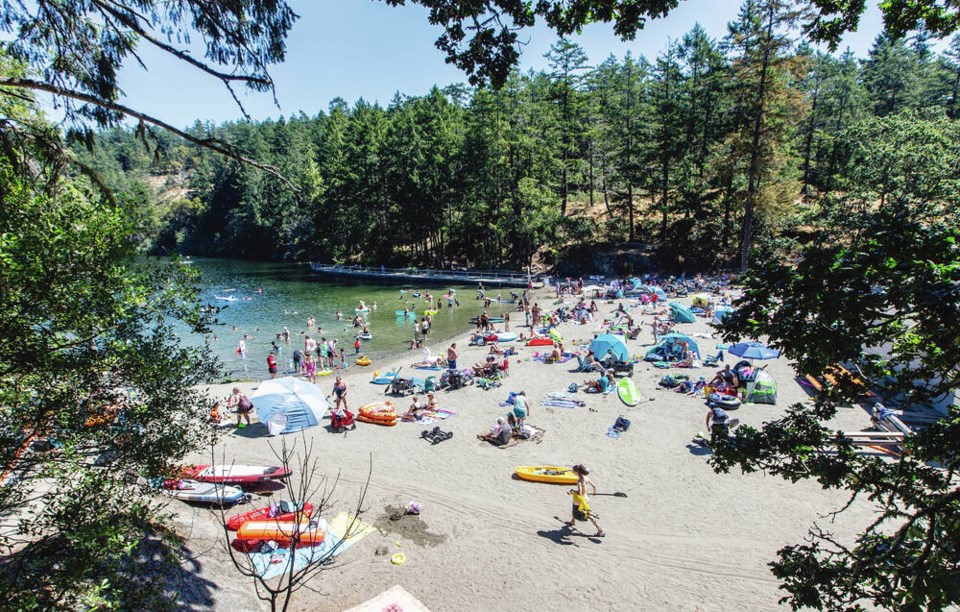Island Health has raised the issue of bringing back lifeguards with the Capital Regional District’s parks committee in the wake of two drownings at area lakes.
There was a drowning in August at Prior Lake and another in September at adjoining Thetis Lake.
In the August drowning, an RCMP dive team recovered the body of a 49-year-old woman two days after witnesses saw someone go under the water and fail to resurface.
The September drowning involved an international high-school student who was found in about 4.5 metres of water three metres from shore.
The CRD had lifeguards at the main beaches at Thetis Lake and Elk Lake for three days a week from 1977 to 2003, but stopped in part because of difficulty finding qualified staff.
In 2017, the CRD looked at a request from View Royal to reinstate Thetis lifeguards following three near-drownings at Thetis that summer.
But then-parks committee chair Mike Hicks said lifeguards couldn’t have prevented the incidents because they occurred away from the main beach. He also noted that the cliff-jumping site where people are sometimes injured is also away from the main beach.
Neil Arason, Island Health’s lead for injury prevention and safety promotion, told the CRD’s parks committee that incidents in local lakes that ended up in the emergency department rose slightly from 2016 to 2022, especially those linked to Thetis Lake and to a lesser extent Elk Lake.
During that time, 22 incidents were recorded at Thetis Lake, eight at Elk Lake and one at both Durrance and Langford lakes.
Arason said the numbers were noted during routine monitoring of emergency-department activity.
“I was looking at opportunities to identify ways that we can reduce injuries and deaths,” he said, adding that statistics from ambulance and fire-department rescue activity related to area lakes could also be compiled.
Arason said his information didn’t come with a recommendation for committee members, but was intended to give them details of what the research shows.
He said he hopes that whatever they decide will include further involvement from Island Health.
For now, the parks committee has recommended that the CRD board ask staff to look further into the information from Arason and come back with their findings.
Arason noted that the B.C.-Yukon branch of the Lifesaving Society “strongly supports” bringing back lifeguards at Thetis and Elk lakes.
“Lifeguards not only save lives through rescues,” the society said. “But they also prevent incidents from occurring, providing water safety knowledge that is applicable for times when there is no lifeguard on duty.”
Arason pointed to an American study that found a 35 to 45 per cent reduction in fatal drownings as a result of lifeguard programs, which can also include signs, boundary markers and having safety equipment such as life rings or life jackets on hand when lifeguards aren’t on duty.
Lifeguards are also trained in CPR and first aid, and can respond to non-water-related incidents such as heart attacks, said Arason.
In 2017, a CRD staff report estimated the cost of having lifeguards seven days a week during the summer at $75,000 per beach, including $68,000 for salaries and $7,000 for equipment and training.
The 2017 report also said that rather than bringing back lifeguards, there should be a continuing focus on signage and education. It said that there are at least eight places around Thetis used by swimmers, and incidents can happen outside of attended areas or when lifeguards aren’t on duty.
The report added that three of the five people who drowned at Thetis from 1999-2017, as well as all four involved in serious incidents from 2014-2017, were international visitors with limited knowledge of English.
A coroner’s report that came out after a 2006 drowning at Thetis said visitors to B.C. might not be aware of how cold lakes can be, and made recommendations leading to the addition of symbols to warning signs made up of “images, shapes and colours that are internationally recognizable.”
View Royal Fire Chief Paul Hurst, whose department covers the Thetis Lake area, said the lake can be “deceivingly cold” and has a lot of steep drop-offs.
One ongoing concern, he said, is that the presence of a lifeguard at Thetis Lake at times prompted parents to leave their children alone at the beach because of “a false sense of security.”
Hurst said he has some hesitation about bringing lifeguards back.
“I wouldn’t be able to support it without some really anecdotal evidence that it would improve life safety at the park,” he said.
Alcohol use and cliff jumping are among the risk factors at Thetis, Hurst said, “and the park rangers and bylaw people have done a really good job the last couple of years of curbing that risky behaviour.”



